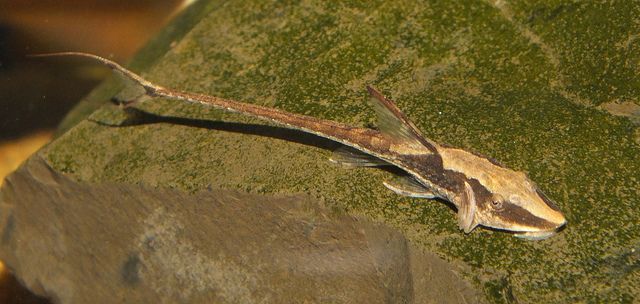
Rineloricaria hasemani:
- Location: Brazil Para, Maguary near Belem in forest streams that empty into Rio Guama.
Rineloricaria microlepdogaster:
- Location: Brazil Rio Grande Do Sul, South East Brazil.
These are very peaceful sucker mouth catfish living in fast flowing oxygen rich water. They grow to about 150 to 200 mm. The males are easily sexed as they have whiskers on the side of their heads (beards), while the females have no beards and their heads are much more pointed. These fish like a water temperature around 24 to 26° C and a pH between 5.8 and 7.8, but I had the most success at around 6.8. They are not fussy eaters, eating algae, bloodworms, live worms and flake food, but being nocturnal they must be fed at night or late in the afternoon.
Breeding.
Whiptails are sexually active after they reach about 90 mm, often before the male shows his beard, and will pair up and breed easily if given the right conditions. I use a 50 litre tank with a gravel substrate, plants, driftwood, a box filter, air stone and a bamboo tube about 150 to 175 mm. long, open at both ends and about 50 mm. in diameter (approximately 1.5 times the width of the fish across the pectoral fins).
Put the tube in a sheltered position, and if conditioned the male will soon claim it. If the female is ready, spawning will soon take place, late in the afternoon. The female will lay 200 to 300 green eggs about 3 mm. in diameter which the male will cover and tend for the next 6 to 8 days, this being time the eggs usually take to hatch. It is advisable to remove the female soon after spawning as I find she will eat the fry. I also remove the male as soon as the fry are swimming, as his job is completed and the fry will not have to compete with him for food.
The fry have a small yolk sac so I start feeding them infusoria and green water on the second day. The water and culture is a lettuce leaf culture, with a pinch of urea to get the algae going, I start the culture the day after the fish spawn. Use the green outer leaves of the lettuce for the culture. I place the lettuce leaf from the culture anchored upright in the tank for the fry to feed on. They will strip this of flesh in a couple of days, so when they have done this, replace it with a new leaf from the culture. Continue this for the first couple of weeks.
I also start feeding brine shrimp on about the third day after hatching and the fry grow well on this diet, reaching about 25 – 30 mm. by the fifth week, when they are big enough to eat chopped bloodworm and daphnia. Once they reach 30 mm., the growth rate slows down slightly but the survival rate is very good and few fry are lost. I raise better than 95%.
Give frequent small water changes.
Good luck and good breeding!
Leave a Reply